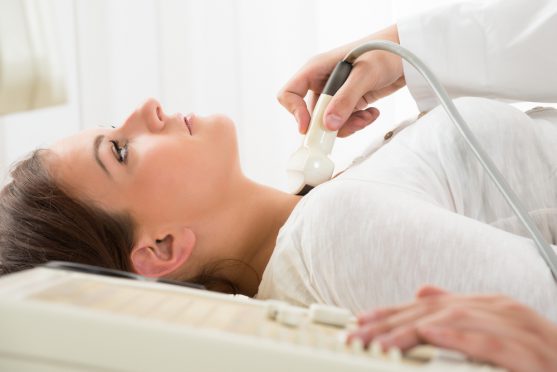Dr Sanjay Sen, MS (General Surgery), FACS (USA), MRCS (England), MCh (Surgical Oncology), helps us understand thyroid cancer; the causes, prevention, symptoms, and treatment.
What does the thyroid gland do?
Thyroid gland is present in the front part of the neck. It’s primary function is to secrete the hormones thyroxine and calcitonin.
The thyroid hormone is important for maintaining the metabolism of the body. It reduces cholesterol, helps with the absorption of food into the body, maintains the temperature of the body, and aids development of the body, especially brain development. It also has a role in menstrual functions, in sleep, appetite, sexual functions etc.
Calcitonin on the other hand helps with bone metabolism. The calcium in the bone and the calcium levels in the blood are maintained by it.
Does thyroid cancer have any symptoms in the early stages?
Thyroid cancer is a very slow growing disease. In the initial stages the patients might experience a lump in the front of the neck, or a persistent cough, slight discomfort in swallowing.
In the later stages, the patients might find it difficult to swallow. They might notice hoarseness in their voice and might experience breathlessness.
Do we know what causes thyroid cancer? Are there any factors that increase our risk of thyroid cancer?
We do not know of definite predisposing factors. That is what makes it so difficult to prevent this disease.
Some factors, however, can be controlled:
A diet low in iodine content can lead to nodular swellings of the thyroid gland. These patients are at higher risk of follicular variant of thyroid carcinoma.
Patients who have a history of radiation exposure have a higher chance of developing papillary thyroid carcinoma.
Certain other genetic syndromes also play a role.
Are there any ways of preventing thyroid cancer?
Children with a family history of multiple endocrine neoplasia 2B, can have a prophylactic thyroidectomy at the age of 1. Children with the Type 2A variant can do so at age 5.
If patients have a history of radiation exposure, they need to be kept under close follow-up.
Ensure you take sufficient iodine in your diet. Iodised salt is easily available in the market for this purpose.
How do you screen for thyroid cancer?
First, a clinical examination will clarify if the lump pertains to the thyroid gland.
Next, a basic ultrasonography of the neck is prescribed. A contrast CT scan or a contrast MRI scan might also be prescribed for further investigation, based on the reports from the ultrasonography.

Ultrasound of the neck
Certain biochemical investigations like the thyroid hormone levels might also be required.
A lump in the neck can also be due to benign causes. The biochemical investigations will be able to give us a better idea of whether the lump is malignant or non-malignant.
Tumour marker tests like serum thyroglobulin are used during follow-up after treatment.
How is thyroid cancer usually treated? How long does the treatment take?
The first step would be to send for investigations. The reports from these investigations would arrive within 7 to 10 days.
Based on these reports, it is likely the patient might be advised to undergo surgery. Surgery might involve removal of a part of the gland or removal of the entire gland.
Along with the removal of the gland, we also need to do a neck dissection for removal of the adjoining lymph nodes.
The patient might take seven to ten days to recover from the surgery. There might be a need for a therapeutic scan post this, in some cases.
The entire treatment process might take six to ten months.
Is thyroid cancer curable?
All cancers are curable if they are diagnosed at an early stage. Curability also depends on the age of the patient.
Anaplastic thyroid cancers do not have as good prognosis as other types of thyroid cancer.
What is the likelihood of recurrence in thyroid cancer?
The size of the tumour being large, inadequate nodal dissection, involvement of larger number of nodes, invasion of blood or lymphatic vessels, delay in radio-active therapy, or the presence of other such factors might increase the chance of recurrence.
What is radioiodine therapy?
In a radio-iodine scan, the patient is given capsules containing iodine which emit radiation that is concentrated in the thyroid gland. The scans are then taken. Within 7 days, the iodine leaves the body through urine.
Radio-iodine scan can be both therapeutic or diagnostic. As a therapeutic scan it is used to ablate any residual disease left in the gland.
When used for diagnostic purposes, a low dose of radiation is used (2 to 3 milli-curies). This helps us check for any residual disease.
When used for therapeutic purposes, a large dose of radiation is given to ablate the residual disease that was found in the neck during the diagnostic scan.
After six months of this procedure, another diagnostic test will be performed to check for any presence of the disease.
What precautions should I take for radioiodine therapy?
Precautions for the diagnostic scan:
If the patient has been breastfeeding, she should completely discontinue it during this treatment. she should completely avoid pregnancies during, and for a year after, this treatment.
The patient should not be in close contact with those who are susceptible to radiation, like elderly people and children. They should not share the same utensils, and should keep a distance.
Since the radioactive dye used for testing leaves the body through urine, the patient must flush the toilet multiple times after use.
Precautions for the therapeutic scan:
The patient is retained in the hospital for seven days after this scan because the dose of radiation delivered is higher.
There are cards that can detect the amount of radiation being emitted by the patient. Once this level is down to the prescribed level, the patient will be discharged and allowed to go home. After that they need to continue to follow the same precautions mentioned for the diagnostic scan.
What is the success rate for thyroid cancer treatment?
For papillary thyroid cancer, the survival rate is 100%, in stage I. It goes down to 80% in stage III. This is a disease with a good prognosis.
In the case of anaplastic thyroid cancer, the survival rate is 30% in stage I and by stage IV it is 4%. The prognosis is poor for this type of cancer. Most patients of this type of cancer present with a mass (lump) which is locally invading the adjoining structures.



